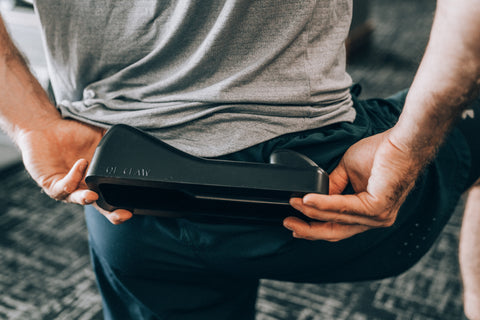
Living with injured glutes is an aggravating way to go through life.
I suffered from deep buttock pain for quite some time and the correction is not nearly as demanding as you may think.
To my surprise, it didn't take multiple visits to the chiropractor or physical therapy office.
The process was much more simple after learning the science behind how our gluteal and lateral hip muscles operate.
In my experience, the two major muscles that have the biggest influence on deep buttock pain are the Gluteus Medius and the Piriformis muscles.
Here's what I've learned.
Deep Buttock Pain - The Gluteus Medius
The Gluteus Medius lies in the upper buttock region of the body above the Gluteus Maximus muscle. The Gluteus Medius functions in isolation as a hip abductor. Hip abduction is the act of lifting the leg away from the body. Gluteus Medius also has secondary functions in stabilizing the pelvis and lifting objects.
Gluteus Medius pain can feel sharp and severe when injured. Check out the red pain patterns in the visual. Notice how pain can move into the tailbone and lower back area. If you're someone who has lower back tightness, trouble moving laterally, or difficulty standing on one leg, the gluteus medius is a likely culprit.

Gluteus medius tear test: At-home mobility and strength tests (such as the single-leg stance test) can also help identify a possible tear and the kind of ailment you're dealing with.
Deep Buttock Pain - The Piriformis
The Piriformis is a muscle located deep in the glute muscle group. The Piriformis Muscle connects from the tailbone the to top of the femur, and lies underneath the large Gluteus Maximus muscle. The main function behind the Piriformis is its function of powerful external hip rotation.

A large contributor to deep buttock pain is excessive inactivity. Being immobile and sitting all day allows the Piriformis to tighten up and cause a world of hurt. In order to relieve injury to this area you must relieve the muscle of it's pent up tension.
Unlike the Gluteus Medius muscle, the Piriformis is deeper and more difficult to pinpoint. Considering its function and location, deep tissue massage is the best alternative to freeing the Piriformis of tightness and pain.
What Worked For Me?
Before the pain struck I was happy, fun to be around, more productive, I could go places comfortably, and I wasn’t constantly stressed.
Countless things I took for granted.
It wasn’t until the pain spread to my lower back that I did anything about it.
I didn’t want to spend hundreds of dollars on physical therapy or chiropractic sessions.
I finally found an approach that worked for me.
I will only ever use QL Claw for Gluteus Medius and Piriformis release because it takes the guesswork out of the equation.
In my experience, it's the best way to break down tight muscle fibers.

The QL Claw's massaging end was created to resemble a massage therapist's elbow, making it ideal for releasing Piriformis/Gluteus Medius trigger points.

Post-Massage Glute Stretches





FAQ
If my glutes are sore, does that mean they're growing?
The short answer in most cases is yes. If you exercise your glutes directly and eat enough to fuel your training, sore glutes are the cost of future growth.
However, if you are not a regular gym goer soreness can be caused by a variety of factors, including injury, stress, muscle tension from overuse, sedentary lifestyle, or even dehydration.
How do I activate my glutes?
Glute activation exercises are a surefire way to wake up your sleepy glutes. Check out 11 glute activation exercises to get a better idea on what works best for you.
How can I release glute pain through deep tissue massage?
For a visual step by step tutorial, check out the videos below - Gluteus Medius:
Here is another video on how to do the same release and stretch combination on the Piriformis muscle:
Sources/Influences:
[1] Davies, Clair, and Amber Davies. The Trigger Point Therapy Workbook: Your Self-Treatment Guide for Pain Relief. 3rd ed., New Harbinger Publications, Inc., 2013.
[2] Donnelly, Joseph M. Travell, Simons & Simons Myofascial Pain and Dysfunction: the Trigger Point Manual. 3rd ed., Wolters Kluwer Health, 2019.


